Melbourne street artist Ms Saffaa painted and wheat-postered a wall with a Muslim feminist protest mural. The collage of Saudi artists and activists shared the space with pink Arabic reading: “radical Muslim.” It took over 80 hours to complete—and one night for someone to blacken out the women’s faces and words. The Guardian noted that the artist “had expected the work to be tagged by other street graffiti artists” but that the piece had “been defaced in an act of vandalism.”
Loyola Marymount University, in Los Angeles, erected a temporary wall on which students sprayed messages including “Stop deportations” and “No human being is illegal.” Later, “vandals” (KABC’s words) spray-painted “Trump” across the messages and altered other lines to read “deport illegals.”
Rice University displays a piece of the Berlin Wall which is covered—as many slabs of it are—with East and West German graffiti. In mid-January, the wall was, according to the Houston Chronicle, “vandalized with pro-Donald Trump graffiti.”
In Detroit, not too far from where I grew up, someone spray-painted “Fuck Trump!” across a brick wall. Days later, the graffiti was modified to read “Trump! 2020!”

Defaced mural by Ms Saffaa; photo credit Twitter/Ms Saffaa.
I’ve done it myself in countless bathrooms: modified a swastika into four boxes or circle-and-slashed it. Yet I also support the right for Nazis (and Neo-) to have marched through Skokie, Illinois. But how is crossing out the symbol any different than not allowing the Nazis to parade? Shouldn’t I have, instead, drawn a Star of David beside it?
I know that, in the case of the “Fuck Trump!” to “Trump! 2020!,” I, like the above news agencies, thought of the former being “vandalized” by the latter. But does defacing only begin when you stop agreeing with the message? And can you deface a defacement? While the Muslim feminist mural was commissioned by the owners of the building it was on, the artist anticipated—and seemed to welcome—other street artists adding to it. Until she disagreed with the embellishments.
It may be unpopular, and a bit simplistic to say, but I believe the same rules apply to graffiti and free speech: If you’re going to believe in free speech, you need to believe in it for everyone. I applauded “Black Lives Matter” sprayed across Trump International Hotel. Though I may disagree with your “White Lives Matter” on a random brick wall, I will defend your right to spray it. But I may add a swastika and arrow pointing to your message.


